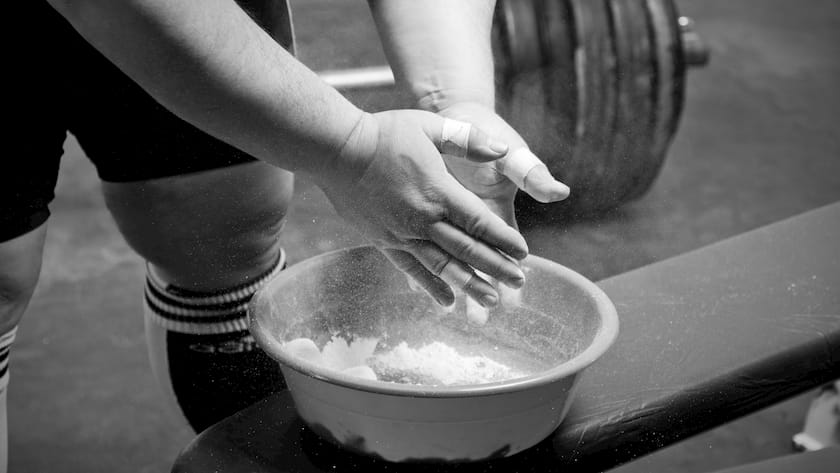Weightlifting chalk is made from magnesium carbonate that has been pounded into a fine powder. It comes in many different forms such as a ball, block, pressed cake, a chalk bag, and loose powder.
The chalk acts as a drying agent for hands by absorbing sweat. This ensures a reliable, firm grip that prevents slipping of the equipment from your hands since even the smallest amount of perspiration on your palms significantly reduces grip strength.
Chalk is a godsend for lifters, but shouldn’t be abused by using it on every set. You still want to build up your grip strength, which using it on every set would neglect. Remember, weightlifting chalk is an accessory so treat it like one.
Andy Bolton breaks down proper chalk use, and he has one of the strongest grips on the planet.
“You may use chalk on your heaviest weights, over 80% 1RM (If you need it for anything less, your grip is most likely weak). The exception to this is on really hot days—when your hands are extra sweaty or slippery, you may use chalk on every set.
The reason for not using chalk until your top weights is simply because it builds better grip strength. This is important for powerlifters and many other athletes. Believe it or not, in my early days when I trained with strongman Jamie Reeves, I’d often deadlift using a bar that had no knurling at all, and I still didn’t use chalk.
This made my grip very strong!” – Andy Bolton
How Liquid Chalk Compares to Powdered Chalk
Unfortunately, due to how messy chalk use can be while lifting, many gyms have banned it altogether. Fortunately, liquid chalk is still allowed in the majority of gyms and while not as good as regular weightlifting chalk, still gets the job done.
Liquid chalk is aluminum chlorohydrate in a quick-dry alcohol solution. When you spray it on your hands, it acts as an antiperspirant and keeps your palms from sweating.
The key with liquid chalk is finding a brand that ads a stick-um like texture to your hands. This can be found in most rock-climbers liquid chalk brands which are generally the best for weightlifting purposes.
Chalk and Callouses
Chalk encourages the formation of callouses which can interfere with training if they rip off, hindering your ability to grip the bar. Besides that, nobody wants to use a bar with someone’s blood on it. So for your sake, and the sake of others, take care of your callouses.
Look into getting a pumice stone or a ped egg to shave them down. Don’t cut them, when doing so you risk damaging the surrounding skin leaving your hands more injury prone. Be sure to give your skin enough time to recover before your next training session.
Also, make sure you are gripping the bar correctly when deadlifting or doing row movements. A lot of people make the mistake of putting the bar in their palm which causes the skin below the fingers to fold around the bar. This dramatically increases the chance of tearing a callous off and hindering progress. Instead, you want to grip the bar right above your fingers.




Leave a comment
All comments are moderated before being published.
This site is protected by hCaptcha and the hCaptcha Privacy Policy and Terms of Service apply.